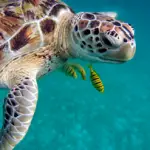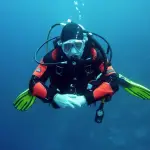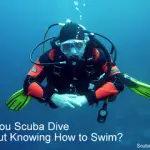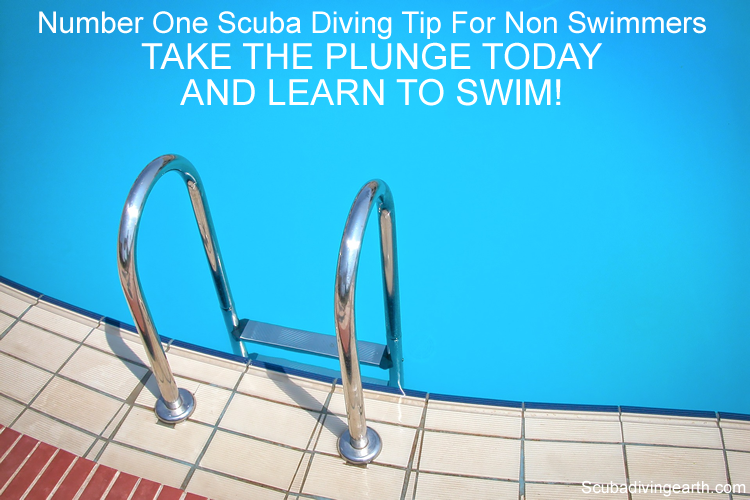
Scuba diving tips for non swimmers; learn to swim or find another sport that doesn’t involve swimming
The minimum requirement for scuba diving is you need to be able to swim. Confidence in the water is a big part of scuba diving and experiencing the underwater ‘foreign environment‘. It’s important to understand at the outset that scuba diving is a dangerous sport.
Do you need to swim to scuba dive? Yes you need to be able to swim to learn how to scuba dive. Don’t even consider scuba diving before you know how to swim. To start scuba diving training you need to be able to swim 200 metres (656 feet) in a swimming pool. Swimming isn’t difficult to learn and is fun once you know how.
The best way to do more diving once you’re a certified diver is to book yourself on a scuba diving liveaboard. You can check the latest and best deals on liveaboards using the following window:
You may also wish to consider snorkeling as a first step to learning to scuba dive too.
Requirements for learning to scuba dive

The first scuba diving tip for non swimmers is you should first learn how to swim. You don’t have to be able to swim well. But you do need to be confident in the water and be proficient at it.
The requirement for scuba diving for most dive training centres is to be able to swim 200 metres (656 feet) in a swimming pool. After that, you’ll be taught all that’s required to be a safe confident scuba diver underwater.
Then you’ll be able to enjoy this wonderful sport and get to dive all over the world.
Is scuba diving safe for non swimmers?
Scuba diving is not safe for non-swimmers. It is for this reason why there’s the requirement to know how to swim before you are able to become certified scuba diver. Diving schools like PADI and BSAC offer excellent scuba diver training.
Scuba diving is not safe for non-swimmers. Scuba diving is classified as a dangerous sport and should be respected as such. Entering the sea not knowing how to swim isn’t safe at the best of times. But diving underwater not knowing how to swim would be foolhardy!
BSAC and PADI both have the same 200 metre (656 foot) swimming test at the start of the training.
But before you learn to scuba dive, you may wish to learn to snorkel first. This will give you added confidence when you begin your training.
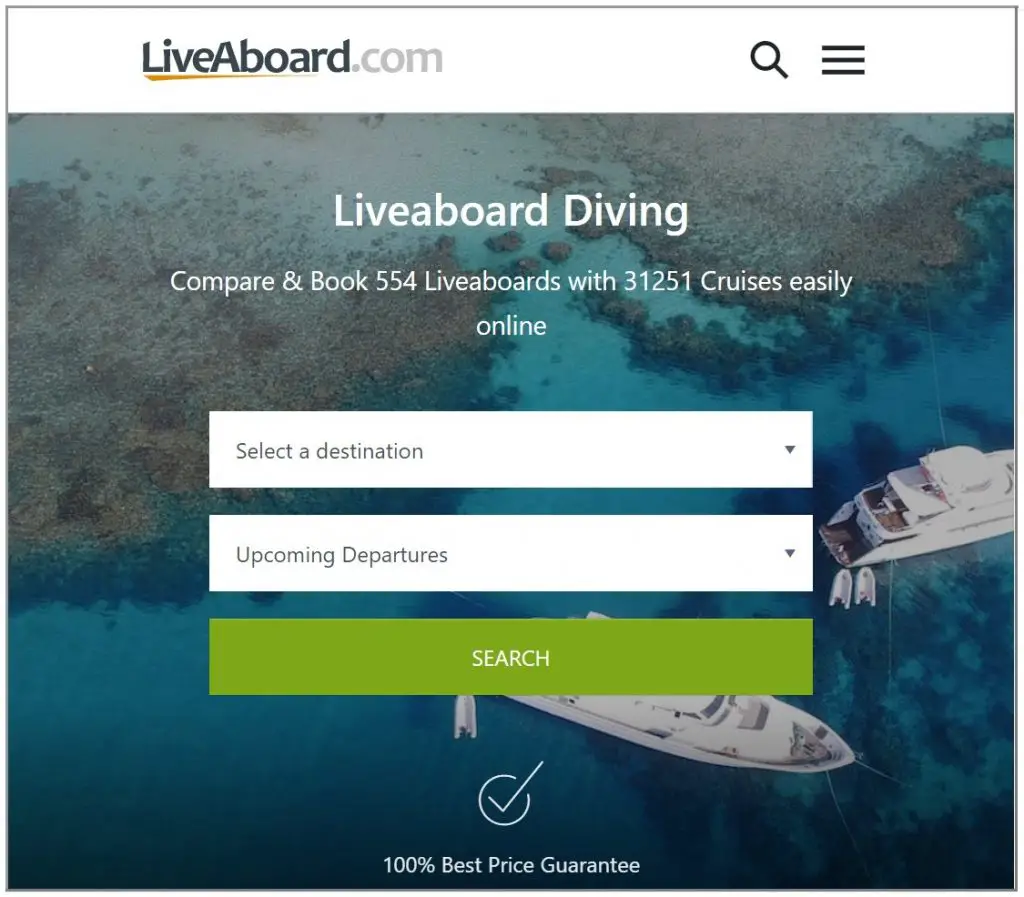
What’s the difference between snorkeling and scuba diving
The main difference between snorkeling and scuba diving is with snorkeling you predominantly float on the surface of the water whereas diving means you spend your time underwater.
There are times when snorkelling that you can dive down using a surface dive. But whenever you dive underwater (free dive/skin dive) whilst snorkeling, you have to hold your breath.
The main difference between snorkeling and scuba diving is that scuba allows you to breathe underwater.
Your time under the water when snorkeling is limited to the length of time you can hold your breath.
The total time you can spend snorkeling is only limited by how much time you have. You’re also affected by how cold the water is, or if you get bored with where you’re snorkeling. Plus you may get hungry and need to return for something to eat!
However, with scuba diving all your time is spent underwater. What limits your dive time when scuba diving is how long your air lasts.
The air you breath is carried in the tank you have strapped to your back. You may like to read these 28 tips on how to conserve your air and lengthen your dive time. These work well for me as a 6’6″ tall guy weighing in at around 250lbs!
Your time underwater on the dive is also impacted by the water temperature.
Other factors that impact your dive time underwater and how quickly you consume your air include:
- Your diving experience
- Your diver confidence and how nervous you are.
- The depth of the dive.
- Your buoyancy control.
Certification requirement to scuba dive
Another difference between these two water sports is to scuba dive you need to be certified. Whereas this is not the case for snorkeling. However, the same diving schools that teach scuba diving, will also teach people how to snorkel too.
The equipment and how much it costs to be a snorkeler is much cheaper than it is for scuba diving. There’s also less equipment needed for snorkeling vs scuba diving.
Can you go scuba diving without a license?
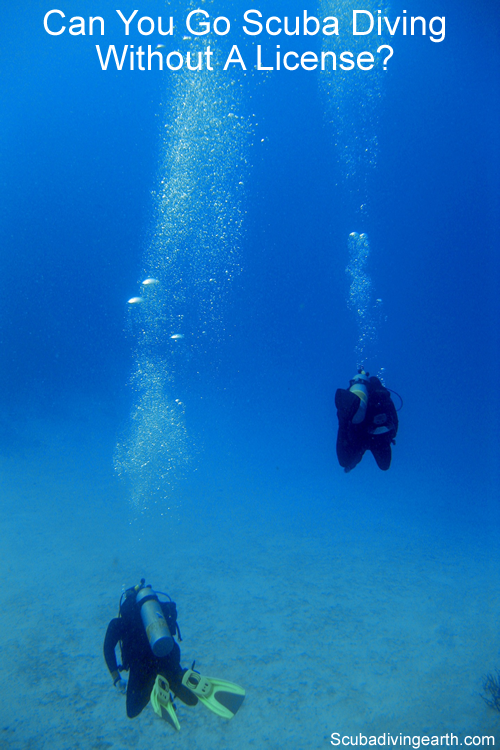
If you want to try diving before you get a licence, you can enjoy a try-dive at most diving schools around the world.
Mostly this will involve kitting up with the relevant diving gear, and being taken in a swimming pool with a qualified and experienced scuba diver trainer. Sometimes this try-dive is done in open water, but in an area that is safe and devoid of currents and at a shallow in depth.
My very first try dive, which is what got me hooked, was off from Cairns, Australia near to the Great Barrier Reef. We had a quick safety briefing on the pontoon where the boat took us to. We were familiarised with the scuba equipment, and then taken down to the bottom.
The first time you submerge under the water it’s a strange feeling to breath. Your brain is telling you one thing i.e., you’re underwater, you shouldn’t be able to breathe, but you know it’s okay.
Trying out scuba diving in this way without a licence, but with someone who’s both qualified and works for a reputable company, is absolutely fine. However, going scuba diving without a licence in any other way is not okay.
Scuba diving without a licence is unsafe and is dangerous. The worst outcome could be death.
There are many lessons to learn and principles to understand about diving underwater. Not least the amount of additional pressure that water exerts on our bodies than the pressure we are used to on land.
You can try diving without a scuba license, but you can’t and shouldn’t dive without one.
So although scuba diving is classed as a dangerous sport, once you are taught properly, you gain experience, and you dive safely by following safe diving practices, you’ll be safe.
How do you get certified to scuba dive?
To get certified to dive, you need to enroll on a course with one of the many scuba diving schools.
The top three diving schools include Professional Association of Diving Instructors (PADI), the British Sub Aqua Club (BSAC) and Scuba Schools International (SSI).
This isn’t a complete list of all diving schools, but these are the top ones. PADI is the most popular, simply because of the number of dive shops and centres around the world (over 6,400, and counting).
There are two parts to the training. The first is the academic side, and is learnt by reading the instruction manuals and through Elearning. This is followed by an exam, which you must pass before you can become certified.
The academic learning is followed by the practical side of the training. Which begins in a swimming pool, and starts with your swimming test. This is followed by some open water (i.e. the sea) training.
After that, it’s about building up your experience by diving to your level of knowledge and experience. Then progressing from there.
How much does it cost to become a certified scuba diver?
The cost of getting certified to scuba dive, will depend on a number of factors.
The first of these is where you choose to learn to dive. If you learn near where you live, there’s only the training costs to take account of. However, if you learn to scuba dive overseas, there’s also the cost of the travel to take account of.
However, you may be on holiday or vacation in any case, so the cost of the holiday or vacation, would be a cost you had in any event.
The cost to become a certified diver does then depend on how much it costs in the country you choose to do the training. This will vary from country to country.
The best way to find out is to first decide where you want to learn, but before that if you can, decide what type of diving you’d like to do. You are better off learning to dive in similar waters to where you want to dive the most. Or at least learn in waters comparable to where the majority of your diving will be.
Once you’ve decided where to learn and the types of dives you’d like to do, the next step is to choose your diver training school.
What are the common depths for people who are just learning to scuba dive?

When you first learn how to scuba dive, it’s important not to go too deep to begin with.
The best dives are not always the deepest ones. Sometimes the most popular are at less than 15 metres (50 feet).
Beginner scuba divers remain in shallower waters of up to 18 metres (60 feet) with PADI and 20 metres (66 feet) as an Ocean Diver with BSAC.
These are limits to not exceed for the beginner level of a certified diver. However, to enjoy diving you don’t have to reach these depths.
There are some extremely popular dives up to around 15 metres (50 feet). One of my favourite dives in Barbados is no more than 10 metres (33 feet). This is the Cement Factory dive. The reason I love it so much is seeing the seahorses that are there. On one dive alone, I counted nearly 30 separate seahorses.
In fact Phil who I dive with in Barbados (great guy by the way), we spend the whole dive trying to count as many as we can.
On this same dive, there’s also a huge abundance of other sea creatures. These creatures include octopus, hundreds of lobsters, moray eels, puffer fish, plus so many others. It’s like an octopuses garden and a must-see-dive.
Scuba diving for non swimmers around the world
As already mentioned, it is possible to experience scuba diving without being certified. It’s also possible to experience scuba diving without swimming skills.
But I’m not sure this is a good idea personally. Entering the water, and worst still diving under the water without any water skills sends the wrong message.
For example there’s scuba diving for non swimmers in Andaman. They describe this as “This is the perfect program if you want to experience scuba diving in a controlled, safe environment. This is not a training course but meant to give you a taste of diving in the azure waters of the Andaman Islands.”
They say there are no swimming skills required. That you’ll be accompanied by a qualified scuba dive master.
Not wishing to spoil the party, and whilst it all sounds good, I’m sure it’s the right thing to do. It seems to be safe and controlled, but I would worry personally about this. I don’t know the depth of the sheltered reef they describe either.
Even those that try this out as non-swimmers, if they enjoy the experience and want to go on to learn how to scuba dive, they’ll still need to learn how to swim first, and then get the certification.
I hope you enjoyed this article about scuba diving tips for non swimmer
I’d love to hear from you. Tell us about your adventures of diving and snorkeling, in the comments below. Please also share your photos. Either from your underwater cameras or videos from your waterproof Gopro’s!
If this article hasn’t answered all of your questions. If you have more questions either about snorkeling or scuba diving (or specifically about scuba diving tips for non swimmers), please comment below with your questions.
There will also be many more articles about scuba diving (and snorkeling) for you to read and learn about these fabulous sports.
Have fun and be safe!

